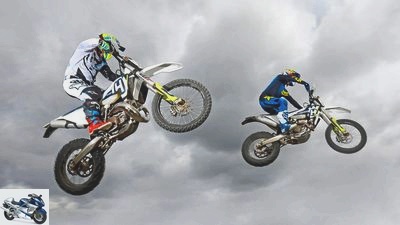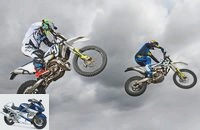Menus

Husqvarna FE 350 and Husqvarna TE 300i in a comparison test
Cloudy to clear
The days of blue two-stroke clouds are (almost) over. Because with one injection, KTM and subsidiary Husqvarna throw the carburetor overboard. The comparison test between Husqvarna FE 350 and Husqvarna TE 300i shows: cheerful prospects for fans of the Schnurle reverse flush.
JEvery gas surge conveys a dense bluish cloud out of the slimline silencer of the TE 300i. Didi Lacher, former six-time German motocross champion and off-road expert from MOTORRAD, is confused. Did the injection just turn the carburettor-fed two-stroke engine into an e-cigarette? To anticipate: there is only smoke in the cold running phase. As soon as the engine reaches operating temperature, there is no longer any visible blue haze. As promised.
Buy complete article

Husqvarna FE 350 and Husqvarna TE 300i in a comparison test
Cloudy to clear
FE 350 3.3 liters per hour, the TE 300i 3.7 liters. For a two-hour enduro on sandy or fast slopes, the reduced fuel supply to 9.25 liters still demands nerve strength. Incidentally, the ten-liter tank of the 2017 TE models does not fit the current 300.
Nevertheless: With Didi Lacher the confusion is gone. Because the two-stroke has remained true to itself even after the technical high-gloss polish. Anyone who has liked two-stroke engines so far will find the injection engine even more likeable because of its stable idling, fine throttle response and lower consumption. The only difference is that four-stroke fans will still not – yet – change their minds about the new technology.
MOTORCYCLE conclusion
And what is the bottom line? Everything the same as before. Nearly. Because the injection transports the two-stroke engine into the modern age and still retains the simple technology – but also its character. Experienced pilots are required to use the qualities of the extraordinarily potent propellant. Everyone else will be happier with the uncomplicated 350.
A rare species: two-stroke fuel injection
Small, light, powerful – the two-stroke engine would be the perfect motorcycle engine. But high consumption and dirty exhaust emissions are always a cause for concern. Not only Husqvarna and KTM have to prove that gasoline injection can cultivate technology.
fact, Husqvarna
1997: With the Vdue, Bimota builds a two-stroke engine with injection. The project fails.
Only three moving parts (crankshaft, connecting rod, piston), compact dimensions (no high-rise valve train), low weight and high specific power (ignition with every revolution) – there are strong arguments in favor of the two-stroke engine in a motorcycle. The only horse’s foot: the high flushing losses when changing gases spoil the exhaust gas and consumption balance. All attempts to minimize this shortcoming are based on one idea: The burned exhaust gases are first flushed out with clean air. The combustible mixture enriched with petrol should only then flow in with the outlet channel largely closed.
One of the most spectacular two-stroke initiatives was undoubtedly the 500 Vdue from the high-end manufacturer Bimota. Two injection nozzles per cylinder supplied the 110 hp tandem engine (two counter-rotating crankshafts) with petrol.
fact, Husqvarna
2017: The E-Tec two-cylinder from Rotax with direct injection – for boats and snowmobiles.
However, the Italians never brought the machine, which was calculated at 30,000 marks and weighed 175 kilograms with a full tank, to market readiness. In 1997, Vdue was discontinued shortly before the start of series production.
While the injection nozzles are placed in the transfer channels with Bimota and TPI technology from KTM / Husqvarna, the Austrian engine specialist Rotax goes one step further. In the E-Tec two-stroke engine, the injection nozzles are located in the combustion chamber so that the mixture can only be injected when the channels are completely closed. This two-cylinder (600 to 850 cm³) is the only two-stroke engine that deserves the designation of direct injection. The twin, with up to 165 hp and turning over 8000 rpm, is currently only used in boats and snowmobiles.
Related articles
-
BMW G 650 GS and Husqvarna TR 650 Strada in comparison
Gargolov 13 photos Gargolov 1/13 The Strada leads to a brisk pace on the route. Gargolov 2/13 Not perfect, but with a temperature display and average…
-
Comparison test Aprilia RSV4 R APRC and Ducati 1199 Panigale
fact comparison test: Aprilia RSV4 R APRC and Ducati 1199 Panigale The best Italian superbikes in comparison The more expensive versions first – few …
-
Comparison test MV Agusta F3 800 and Suzuki GSX-R 750
21 pictures 1/21 Comparison test MV Agusta F3 800 and Suzuki GSX-R 750. 2/21 Comparison test MV Agusta F3 800 and …
-
KTM 990 Supermoto R, Ducati Hypermotard and Husqvarna Nuda 900 R ABS in the test
fact 31 pictures fact 1/31 Husqvarna Nuda 900 R ABS, Ducati Hypermotard and KTM 990 SM R in a comparison test. fact 2/31 Husqvarna Nuda 900 R ABS. fact 3/31 …
-
Husqvarna, Ducati and Aprilia Supermotos in the test
22 pictures 1/22 The three fun bikes: Husqvarna Nuda 900, Duacti Hypermotard 1100 Evo and Aprilia SMV 750 Dorsoduro – in …
-
90 hp naked bikes in a comparison test
fact 27 photos fact 1/27 One look at the performance diagram and it becomes clear: Even within the 90 hp middle class, there are worlds between the…
-
350cc sport enduro bikes from Beta, Husqvarna, KTM and Sherco in a comparison test
Gargolov 22nd photos Gargolov 1/22 350 series enduro bikes in comparison: Beta RR 350 EFI, Husqvarna FE 350, KTM 350 EXC-F and Sherco 300 SEF-R. Gargolov…
-
Sport-Enduro comparison test Beam man and sons He who laughs first laughs best. With the new 520 Racing, KTM wants to stir up the sports enduro market….
-
Husqvarna TR 650 Terra, KTM 690 Enduro R and Yamaha XT 660 R in the test
Jahn 22 pictures Jahn 1/22 Husqvarna TR 650 Terra, KTM 690 Enduro R and Yamaha XT 660 R in the enduro everyday comparison test. Jahn 2/22 Husqvarna TR 650 Terra ….
-
Husqvarna 701 Supermoto, KTM 690 SMC R, SWM SM 650 R and Yamaha XT 660 X in the test
31 pictures 1/31 Power on the crankshaft. Measurements on the Dynojet roller test stand 250, corrected according to 95/1 / EG, maximum …